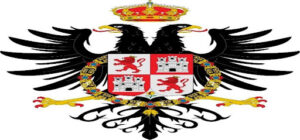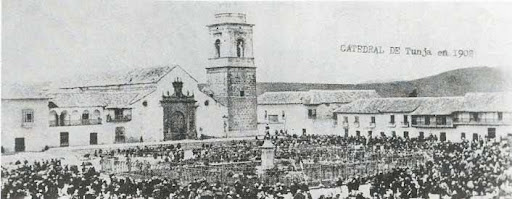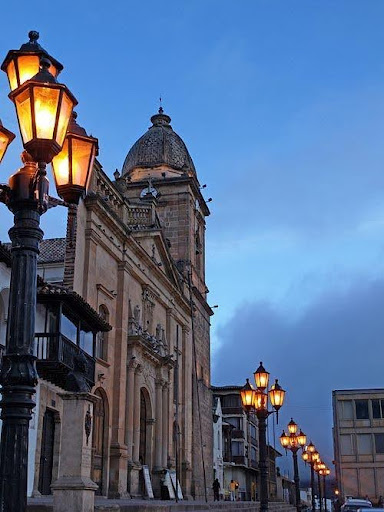Tunja
Department

Flag of the city

Seal of the city
The coat of arms of the municipality of Tunja, Boyacá (Colombia) was granted by King Charles V on March 29, 1541. It features a heraldic shield with a Spanish-French shape, quartered by a cross and with a triangular escutcheon at its tip. The first and last quarters show a silver field with a rampant lion in red, with a matching red tongue and crown. The second and third quarters display a red field with stone-colored battlemented towers. The triangular escutcheon on the tip presents a silver field with a split pomegranate in red and green leaves, symbolizing the religious and territorial unity of Spain since the time of the Catholic Monarchs and also representing the New Kingdom of Granada. Above and framing the shield is a splayed eagle in black. Hanging from its wings is the “Golden Fleece”, emblematic of the Duchy of Burgundy, established by Charles I of Spain and V of Germany, its collar consisting of gold links and flints emitting flames, from which hangs the fleece of a ram. Atop the shield is a royal crown.

The slogan of the city
Tunja is a renowned educational hub with prestigious universities. Before the Spanish conquered the Muisca territory, it was home to an indigenous settlement named Hunza, ruled by the chieftain Eucaneme. The Spanish conquistadors took over this settlement on August 20, 1537.
History
The Altiplano Cundiboyacense region showed signs of human habitation as early as approximately 12,000 years ago. By 6375 BCE, the Homus Tequendama people had settled there. Archaeological evidence, including human skeletons, confirms their presence, with some finds dating back to around 150 BCE.
In the 1st millennium AD, the Muisca, speakers of the Chibcha language who migrated from Central America through Panama, populated the area. They established their own religious, calendrical, and mythological systems. One significant legend speaks of the influential leader and prophet Goranchacha, who relocated the northern Muisca capital from Ramiriquí to what is now known as Tunja but was then called Hunza.
During a period marked by numerous battles among local rulers, a proposal for peace emerged. The leaders decided to elect a supreme ruler to govern all, leading to the selection of Hunzahúa from Ramiriqui. The capital of his domain was named Hunza. Under his rule, the Muisca territories expanded from the Chicamocha to Fusagasugá and from the Llanos de San Juan to the borders of Panche and Muzo, inclusive of Vélez. This era saw an increased unity among the Muisca, particularly in language and religion. However, unity was disrupted by disagreements between various leaders.
By 1490, significant changes were happening. Notable battles, like the Battle of Chocontá, left both opposing leaders dead. In this tense climate, Eucaneme emerged as a new leader. As European intentions to expand became clear around 1514, Eucaneme sought the support of neighboring rulers to bolster his forces. However, upon realizing the imminence of the European arrival, Eucaneme opted for a more pacifist approach, sending gifts and peace offerings, all while safeguarding his treasures.
The Spanish colonization began in earnest in 1537 when Gonzalo Jiménez de Quesada, in pursuit of the legendary El Dorado, encountered numerous Muisca territories. By August 20, 1537, the Spanish had arrived at the domain of Quemuenchatocha, seizing treasures and capturing the leader. The subsequent invasion saw Aquiminzaque, Quemuenchatocha’s successor, under Spanish command, facing internal dissent and external challenges.
The formal Spanish establishment of Tunja was on August 6, 1539, by Captain Gonzalo Suarez Rendón. With its establishment came the arrival of various religious orders, the development of public spaces, and the organization of the city. However, more details of this era remain to be elaborated upon.
Modern-day Tunja is noteworthy for its exceptional safety standards. As of 2015, its homicide rate stood at 2 per 100,000 inhabitants, making it one of the safest cities in the Americas and far safer than the national average. This remarkable safety record positions Tunja as a model city in terms of security.

Geography
Tunja, positioned in central Colombia with coordinates approximately at latitude 5.5353° N and longitude 73.3678° W, has a population of 172,548 as per the 2018 Census. The demographic profile of the city reveals that 0.1% are indigenous, 0.4% are black, and a significant 99.5% are a combination of white and Mestizo. Geographically, Tunja’s elevation ranges from about 2,700 metres (8,900 ft) to 2,900 metres (9,500 ft), and its city centre stands prominently at an altitude of 2,820 metres (9,250 ft) above sea level.
Tunja’s climatic conditions are predominantly shaped by its geographical location and considerable altitude. Being one of Colombia’s elevated cities, almost touching 3,000 m, it experiences a subtropical highland climate (as classified under the Köppen Cfb category). While temperature variations remain subtle throughout the year, the city does undergo a distinct dry phase from December to February.

Population
218 686(2023)
194072 (2019)
172,548 (2018)
One photo representative of the city
The Cathedral Basilica of St. James the Apostle, often referred to as Tunja Cathedral, stands as Colombia’s oldest Roman Catholic cathedral. Dedicated to St. James the Greater (Santiago Apóstol), it graces the eastern side of Plaza de Bolivar in Tunja, situated in the historical heart of Tunja city, the capital of the Boyacá department in Colombia.
Serving as the primary church for the Archdiocese of Tunja, it was elevated to the status of a diocese by Pope Leo XIII’s Bull “Infinitus amor” on July 29, 1880.
Initiated in 1567 by Pedro Gutiérrez under the commission of Juan de Castellanos and Gonzálo Suárez Rendon, its architectural style primarily resonates with the Isabeline genre. However, subsequent modifications have introduced neoclassical elements to the structure. The cathedral boasts a singular tower and houses three main naves accompanied by side chapels within. In 1598, Bartolomé Carrión crafted its exterior in a distinct Renaissance style.
On December 30, 1959, by virtue of Law 163, the historic section of Tunja, inclusive of the cathedral, earned recognition as a National Monument of Colombia.

Etymology
The etymology of “Tunja” is rooted in the indigenous Muisca language, Chibcha. The original name for the area was “Hunza” or “Chunza”, which was the name of the Muisca zipa (chieftain) of the region before the Spanish conquest. Over time, with the influence of the Spanish language and colonization, “Hunza” transformed into “Tunja”. The term “Hunza” itself possibly referred to a local indigenous meaning, though specific interpretations might vary. The Muisca people, who inhabited the Altiplano Cundiboyacense where modern-day Tunja is located, have a rich history and culture that has significantly influenced the identity and heritage of the region.
What the city is known or famous for
The city of Tunja is a treasure trove of Muisca heritage, boasting significant remnants such as the Hunzahúa Well, Goranchacha Temple, and Cojines del Zaque.
Tunja is not just an historical gem; it’s a sought-after tourist destination, particularly famed for its colonial religious architecture. Among its notable structures is the Casa Fundador Gonzalo Suárez Rendón, the city’s most ancient edifice. Beyond its rich history and spiritual sites, Tunja plays host to a number of internationally recognized festivals, making it a vibrant hub of culture and entertainment. Moreover, the city serves as a gateway to other regional attractions, including Villa de Leyva, Paipa, and the stunning Sierra Nevada del Cocuy.
For those journeying across the continent, Tunja is strategically positioned on the Pan American Highway. This major route provides seamless connectivity from Tunja to Bogotá and Santa Marta, and extends further too the most northern and southern tips of South America.
